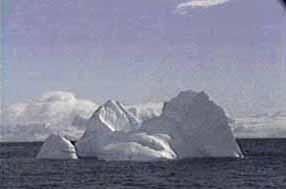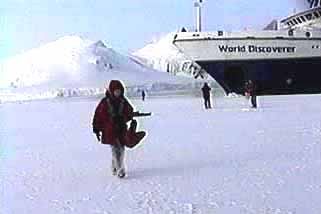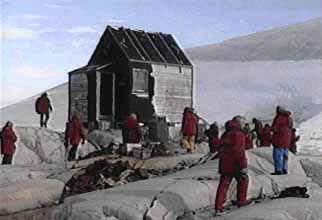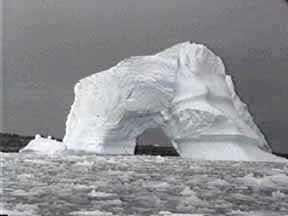Saturday: Cuverville Island/Paradise Bay
In order to get in another FULL day in Antarctica, complete with landings and Zodiac tours, we started early. The first group left at 7:00am and the second, fifteen minutes later. The seas were calm and the light was perfect for photographs.
About fifty yards from the beach at Cuverville Island we could smell them before seeing them. As we drew closer, we could hear their noisy cackling chatter. Penguins, of course.
The two huts and yellow tents near the Argentine base site were being used by a biologist, Bernard Stonehouse, and his international team of researchers, who were studying the affects of tourists upon a penguin rookery. Oddly enough, they used the huts for their work and slept in the tents. Some of us had already met two of the researchers when they had come aboard for breakfast.(Often, those based in Antarctica would come aboard for a meal or a shower and a visit.)
When it was time to return to the ship, we cruised through the area, among icebergs that were grounded along the shoreline. It was a magnificent gallery of ice sculptures. I had had no idea they came in such a variety of shapes and sizes. Truly breath-taking!

We had already seen many fur seals and one Weddell on the island, but nothing could compare with the sighting of our first leopard seal. They are fierce predators with a taste for penguins.
The water was crystal clear, as it is here, and we watched in amazement as he came very close, turned his belly up under the Zodiac and suddenly shot up, head out of the water,next to us. We were warned to keep our hands inboard. He followed us for quite a distance.
We returned to the ship with an extra person. Cora, a Dutch botanist, who had been studying the vegetation on the island, was being transported out of the Antarctic on the World
Discoverer.
It was time to set foot on the mainland of Antarctica at Paradise Bay. Our
previous tops had been on islands. The Argentines had established a base at
Paradise Bay called Almirante Brown. One of the highlights of the stop was a walk through deep snow up to the top of a point about 500 feet above sea level.
The major purpose in making the climb was not for the view but to slide backdown the hill. One of the crew broke a leg coming down. He couldn't work after that, but there was no way to get back home.
After purchasing pins and patches (there was a souvenir shop of sorts), we
decided to get a better look at Paradise by way of Zodiac. We rode the Zodiacs
along the glacier wall farther back in the bay, occasionally stopping to
photograph a seal or two. Most were Crab-eaters although we did see one Weddell.
It became somewhat dark as the weather appeared increasingly threatening. Snow
flurries sprinkled the deck of the Zodiac as we cruised through the ice. It was so thick it was like driving through slush. I was happy our driver had a radiophone as we couldn't see the ship, let alone any other Zodiac. He kept in constant touch with them.
Whales have a habit of appearing at meal times. We were having finger
sandwiches in the Lido Lounge at 3:30pm. The "whale" call came and people started running to the cabins for parkas and cameras. We came up on deck as fast as possible. We stood outside to watch the humpbacks surface, blow, then sound. They may have interrupted our meal, but it was time to come up on deckanyway because we had approached the Lemaire Channel. It is considered to be the most beautiful natural wonder in the world.
The ice floated by as if in a frozen dream, the ship sometimes meeting a mass of obstinate ice. The hulls reverberated with the crunching thud of metal against mineral. We witnessed a minke whale sounding and blowing. Three more humpbacks were sighted by the bridge.
No restaurant in the world could offer a more spectacular view than the one we had sailing through the Grandidier Channel. From our seats in the dining room we watched many seals lying on the ice floes. We also saw our first Adelie penguins.
The captain, aware that many of us would prefer not sailing outside of the
protected channels, was going to try to grant us our wish. He would try to
navigate through the Grandidier Channel. But he couldn't, so he backtracked
during the night and went out into open water. It was a rough ride that night.
This had been an action packed day: ice, mountains, mammals, and birds, and
Mike had more in store for us. We were STILL heading south!
Sunday: Detaille Island
Who among us imagined, at the beginning of this expedition, that we would cross the ANTARCTIC CIRCLE? This morning Wayne delivered an appropriate lecture on The Magic of Antarctic ice. Who would have thought that the beautiful blue ice we had been seeing was the result of very dense ice trapping all the colors of the rainbow except blue?
Before noon, we all donned our red parkas and met outside on the pool deck in anticipation of the crossing. Mike, on deck, and the captain, on the bridge, were in radio contact for the countdown and we were being served champagne. Of about 4,000 people a year who visit the Antarctic, only about 300 get to cross the Circle. At 12:04pm we toasted our achievement.
We were sailing through Pendleton Strait enroute to Detaille Island. later we began our pilgrimage ashore in the Zodiacs, weaving our way through propoising penguins and bits of brash ice.
Detaille Island is the site of an abandoned British Antarctic base. Although it had been abandoned 34 years ago, it was like entering a hut that was still
inhabited. Skis stood up against the wall, tools sat on the work bench where they were left. Shelves were full of cans of Scot's porridge, oats, bottles of
mayonnaise, and there was even a bucket of coal next to the stove.
We obviously had a lot to discuss at recap time today. But just as Pete was
ending his recap, the Captain came down to say there were five humpback whales at the bow. "Grab your cameras and photograph those flukes?" was all we heard.
Dinner was delayed again!
When we finally did make it to the dining room, the ship continued on a
southerly direction until we could go no farther. Gradually we realized the staff had disappeared. We looked out of the window upon a truly incredible scene. The World Discoverer had definitely reached its southernmost limit. She was parked with her bow wedged into thick fast ice.

We made our way to the bridge wings where we saw the some of the staff already in a Zodiac and landing on the ice. They spread out onto the huge flat expanse of sea ice and walked in all directions. They gave the thumbs up, it was rock solid. And we were allowed to "come out and play." It was awesome!
Sadly, we were eventually recalled and we realized that from our position, we had to begin our journey north. What an incredible experience we had just had!
Monday: Prospect Point
Our daily program said it all with the heading: "Expedition Day." Because we were the first passenger vessel of the season in the area, the ice conditions were unknown. Our Zodiacs set off in all directions. We were using the 'buddy' system so always had another Zodiac close at hand. There was a lot of pack ice.
We were with Sonja, and Mike was our buddy Zodiac. I was fortunate to be in one of these Zodiacs because of this particular experience and I was able to capture it all on my camcorder.
We saw a leopard seal catch an Adelie penguin and saw it thrash it repeatedly on the water surface. As bits of it broke off, they were devoured until only the head and feet remained to float away and become skua food. The leopard seal was huge. It rolled over and swam under our Zodiac several times. Really a beautiful animal. I must have over half an hour straight of tape filming this mammal. It was truly an exciting experience!
We also saw another unusual scene. A crabeater seal was lying on its back about six feet under water. It was later established it must have been dead.
For our second outing of the day, we approached Prospect Point. There was an abandoned hut was closed in 1958 and wass still very much intact. Dog sledging equipment was seen everywhere.
At recap, we heard the history of Prospect Point. Cora told us about her experiences on Cuverville Island where she had been stationed for the summer. And the other naturalists had very interesting points to make. During the day, "Antarctica" by Vangelis was piped throughout the ship. That piece of music really does capture the essence of Antarctica.
Tuesday: Foyn Harbor/Charlotte Bay
Foyn Harbor was names after a Norwegian entrepreneur, Svend Foyn. he had becomve rich from sealing, and started looking to the possibilities of harvesting blue whales. Because of their speed, they could not be caught by the old whaling methods. He spent five years and 20,000 pounds developing a gun harpoon with an explosive head. It was ironic that two minkes should appear as we entered this harbor, as they are the one whale that is still being commercially hunted.
Another beautiful day, so our program was changed to allow us more time for a landing and a Zodiac tour. There was much evidence that this island had been a whaling area. There were water boats, planks, and barrels, as well as a shipwreck in the bay, an old whaling factory ship, which lay half submerged in the water. We were able to investigate it thoroughly from all angles from our Zodiacs.
The wind picked up and the swells were increasing as we made our way back to the ship for lunch. For the people who had signed up for whale watch, it was back to work as we cruised to Charlotte Bay. The conditons were perfect to add an unscheduled landing.
We disembarked on a spit of land called Portal Point. We found a small abandoned British refuge hut tied down with guy wires to the rocks. We went into the hut and were amazed to find everything intact. We looked through some of the old magazines. There were full ration packs, and even a hot-water bottle lying on the table.

Some climbed up behind the hut onto an ice-covered hill. I tried several times, but kept sliding back down. It was up three feet and down four. Never could manage.
For lunch we were treated to a seafood extravaganza! The galley staff never ceased to amaze us with their presentations of endless delectable delicacies.
The whale watch continued, and again it paid off. Two humpbacks were sighted at the bow. We steadily approached the whales. They both remained at the surface a long time. The larger of the two rolled repeatedly onto its side or back, lifting its huge fifteen-foot flipper into the air and exposing the throat pleats. Meanwhile, the smaller one remained quite near to the larger one. Pete was very excited, probably the most excited person on deck and he was the expert. Finally realized we were witnessing a mother nursing its calf. We were SO close it was almost emabarrassing. Really marvelous! And I was able to get it all on tape.
At the evening meal, everyone was abuzz with whale talk. Then five more minkes and three humpbacks were seen at the bow. (I don't believe I ever sat through a complete meal except for breakfast.) One of the minkes glided close to the ship and we could look down from the bridge wing to see the shape of the whole animal under water. Meanwhile, the humpbacks turned their attention to feeding, and we watched as they broke the surface with their mouths wide open as they lunged for the krill. The rosy glow of the setting sun cast an ethereal tone over the mountains and the mirror-like sea. It was other-worldly.
I stayed out on deck and talked with a couple crew members who told me how unusual this trip had been. Normally the weather is quite nasty and a day or two of sunshine is about all one can expect. We had six or seven days of beautiful weather. They told me how fortunate we had been, because we saw and did much more than the average, including crossing the Antarctic Circle.
It was a sobering thought to realize that only a handfull of people had traveled these seas before. As to the glaciers and mountains that surrounded us, without a doubt, no human had ever set foot on the surface for as far as the eye could see. There must be a word that goes beyond 'pristine.'
Wednesday: Neumayer Channel/Palmer Station
We cruised through the Neumayer Channel between Anvers and Wanke Islands on our way to Palmer Station, a U.S. research site. Although our weather credits seemed to be running out, few people were going to stay indoors when the first sighting of killer whales on this voyage was announced. So we donned our parkas and stook out on the deck for as long as we could stand it. Three killer whale bulls were keeping pace with the ship and giving us good views of their six-foot dorsal fins.
After a barbecue buffet was served in the Marco Polo Dining Room, we dropped anchor in Arthur Harbor, off the south of Anvers Island. Sharing the harbor with us, was a huge iceberg with a beautiful natural arch in it. The day before, the main arch had calved, sending 15-foot tidal waves toward the station. Immediately after lunch, researchers from Palmer came aboard to talk to us. Shortly after, we divided into two groups and visited both the island of Torgerson and the station itself. Maneuvering through the brash ice was tedious and unavoidably slow. Sharp ice punctures Zodiacs and the larger bits break propellors.

On Torgersen we were met by scientists, and after a brief introduction were left to walk around the island at leisure. At the base we had a guided tour by other staff members. After the tour, we gravitated to the apple turnovers and coffee, where we sighted the visitors book and the shop. The tour of the base was one of the high points of the trip.
Earlier that day, our passports had been gathered and were taken ashore to be stamped, a procedure which normally doesn't occur.
As we left the bay, we were just able to see the wreckage of the Bahia Paraiso, an Argentine ship which sank near the station not too many years ago. It was our last stop in Antarctica and time to say goodbye.
From the dining room windows, we saw eight snow petrels, the only all-white petrel in the world, which never leaves Antarctica's ice gardens. Suddenly, just as it had first appeared a week ago, the ice was gone. In its place was the endless sea of the Drake Passage.
Thursday: Drake Passage
We woke to sunshine, blue skies and a calm Drake. A busy day lay ahead of us and we hoped that the good weather would hold. Tony Soper's History, Penguins and Politics was the first of many lectures for the day.
At 10:30am, all activities moved back to the Lido Lounge. While bouillon was being served, Gina and Christine were collecting, cleaning and storing all the borrowed boots, as well as those that had been donated because they were too heavy or smelly (from guano) to take home. I donated mine. I had bought them for $1.00 at a garage sale, they had served their purpose and maybe someone on another voyage could use them.
Sonja was there to teach us how to stuff our parkas into their hoods. At first, this seemed to be a 'mission impossible,' but soon we were walking back to our cabins with our little red bundles. Wish we had known how to do this before the trip. It would have been easier carrying them.
Back to the lecture hall to hear a most interesting talk about the Ozone. And also learned that there are about 50 research stations open during the summer in Antarctica, with about 4000 persons. Winter is so harsh that a skeleton crew stays on at only the largest stations.
The evening's video was "Antarctica: Man and Dog." Ironically, this is the last season in which huskies will be used in the Antarctic. Animals that do not naturally occur on the continent can no longer stay. Sadly, due to Britain's strict quarantine laws, their dogs cannot return home, and will therefore, be destroyed. (Have since been told that they no longer destroy the dogs.)
Friday: More Drake Passage
Back in the Drake, it was business as usual - meals, lectures and whale watching. It seemed that no matter what subject was discussed, the conversation always reverted back to our experiences of the past week. Everyone had to admit that it was "THE" special place to visit.
Soon it was time to get ready for the Captain's Farewell Cocktail and Dinner Party. We raised our champagne glasses to toast the captain. After all, we had survived our expedition to ANTARCTICA.
Suggestions as to what to take on such a trip
TRAVEL TIPS --
PACKING LIST--
HOME PAGE